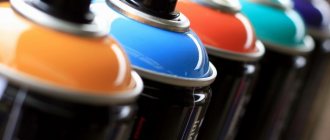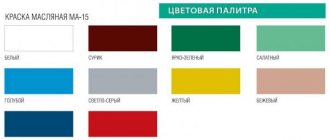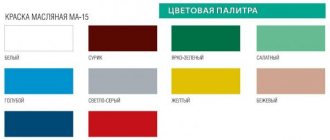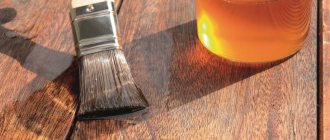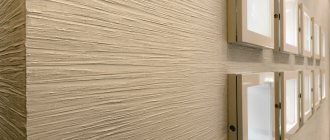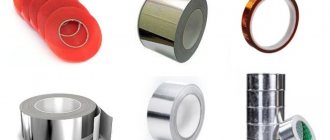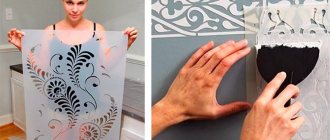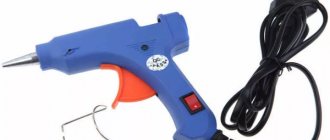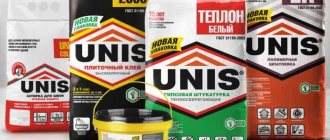Paints and varnishes in cans are especially popular, due to their ease of use, the creation of a thin coating, and the absence of the need to purchase additional tools for painting. But aerosol products are not always suitable for repair work, so before choosing an option, you should evaluate all aspects of the application. Aerosol varnish, when it is best to use it and the nuances of the material will be discussed in the article.
Aerosol varnish - what is meant by this
The varnish in the can is supplied by pressure; finely broken particles of paint and varnish material come out of a special nozzle, which settle on the surface, creating the necessary protective and decorative layer on the base.
During work, the master must monitor the distance to the surface so that it does not change, and the speed of movement of the can so that the layer can be distributed evenly.
The varnish in the can is supplied by pressure, and finely broken particles of paint and varnish material come out of a special nozzle.
Advantages and disadvantages of spray cans
Spray varnish is becoming increasingly popular among consumers for a reason. This type of application has a number of positive aspects. To understand whether an option is worth choosing, you need to study both the pros and cons. The advantages are noted:
- Ready-made product, there is no need to dilute the composition, and even additionally use brushes or rollers for application;
- Easy to transport, you can easily take the aerosol with you;
- No additional money is spent on thinner or accessories;
- Low consumption of varnishes;
- Quick-drying property, the layer does not have to dry for a long time;
- Universal property - can be used for various materials - metal, wood, plastic and others;
- Convenient application to hard-to-reach areas and complex base shapes;
- Aerosol varnish is easy to use, so DIY varnishing is also accessible to beginners;
- A variety of options, not only in technical characteristics, but also in the resulting decorative effect - matte, glossy, colorless, colored.
In addition, aerosol varnishes for wood and other substrates are distinguished by their water-resistant properties, creating a durable film on the surface that does not fade and can withstand changes in temperature.
There are many compounds on sale in heat-resistant cylinders, with protection against rust formations, as well as biological ones.
Among the disadvantages are the following:
- It is necessary to monitor the thickness of the layer; a coating that is too thick will not have good protective properties, and the layer will also take longer to dry;
- Sometimes the spray tip on an aerosol breaks, or the gas runs out, then the varnish cannot be used;
- It is necessary to ensure dust-free drying of the layer.
Aerosol varnish is easy to use, so DIY varnishing is also accessible to beginners.
Aerosol can device
Paint varnish in cans has the same principle of structure and action. The cylinder has a concave bottom to create protection from excessive pressure. Inside the container is loaded with paint, inert gas, and a special tube that allows the composition to come out. A valve is installed at the top point, which serves as a spray safety valve, which can only occur after pressing the valve.
Varnishes in cans for wood and other types contain a solvent in such an amount that the particles can be sprayed without difficulty. Although ordinary paint and varnish material can be applied in multiple layers.
Paint varnish in cans has the same principle of structure and action.
PAINTER'S TOUCH ULTRA COVER 2X CLEAR SPRAY
PROTECTIVE CLEAR COAT – Acrylic clear coat with silica to protect painted surfaces.
MATERIAL CHARACTERISTICS
- UV-resistant, will protect the surface from fading;
- has unsurpassed covering power due to the high binder content;
- provides long-term protection and wear resistance;
- creates a smooth, durable transparent coating;
- the new, unique spray button system allows you to comfortably paint the surface at any angle, even upside down, minimizing finger fatigue;
- quick-drying;
- easy to apply;
- For interior and exterior use.
ADHESION:
Excellent adhesion to new or previously painted wood, metal, unglazed ceramics, concrete, plaster, brickwork, etc.
Restrictions:
Do not apply to surfaces heated above 93°C or to galvanized metal surfaces.
POSSIBLE APPLICATIONS:
serves both to protect surfaces painted with enamels, decorative paints, etc., and as an independent coating.
VISUAL EFFECT:
dense smooth transparent coating (matte or glossy).
COMPOUND:
acrylic, amorphous silicon oxide + org. solvents
PACKAGE:
spray, net weight - 340 g
CONSUMPTION:
2 sq.m
SURFACE PREPARATION
Remove loose paint and rust with a stiff brush or 80-150 sandpaper.
Remove all sanding dust with a vacuum cleaner, then wipe with a damp, lint-free cloth and dry the surface thoroughly.
APPLICATION
Apply protective varnish outdoors or in well-ventilated areas. Apply at air and surface temperatures between 10°C and 32°C and relative humidity below 65% to ensure proper drying. Do not spray in strong winds or heavy dust. Cover all surrounding objects to protect from colorful mist.
Shake the can vigorously for 1 minute after you hear the mixing ball rolling around inside. If you cannot hear the sound of the mixing ball inside, do not start working with the spray! Shake the can frequently during application.
DRYING TIME
At 21°C and 50% relative humidity
- until sticky – 20 minutes;
- light use – 1 hour;
- re-application - within 30 minutes or after 48 hours;
- Complete drying - 24 hours.
NOTE: On plastic, maximum paint adhesion and durability is achieved after 5-7 days. Cleaning: Precautions: Do not insert a pin or other objects into the channel. Pressurized cylinder
Protect from direct sunlight and heat above 50°C. Do not pierce or burn even after use. Do not spray near open flames or hot objects. Do not smoke while working. Cylinders may only be thrown into designated areas.
FIRE HAZARD! Keep away from children!
BEST BEFORE DATE:
Application area
Transparent aerosol plastic varnish and many other types allow you to choose products for various applications. But more often the composition is selected for processing the following products:
- For repair work on the car body;
- To protect wooden bases and furniture;
- To create a protective layer on works of art;
- For processing musical instruments. For example, piano surfaces;
- For barrier coating on elements in the bathroom;
- For varnishing toys;
- For construction stages;
- In the electrical engineering field.
There are many specialized aerosol compositions on sale, so you should first read the purpose of the varnish on the packaging. Then it will be possible to obtain the optimal option for certain operating conditions.
There are many specialized aerosol compositions on sale, so you should first read the purpose of the varnish on the packaging.
What products should not be used for plastic products?
The following products are not recommended for use on plastic parts:
- any types of nail polishes, they are short-lived and will begin to stick after a short time;
- universal acrylic varnish. If it is not marked that it can be applied to plastic parts, then it will not dry on this material. You can use acrylic varnish for plastic only if it contains polyurethane and is marked “for plastic”;
- aerosols for hair. These products are not antistatic and do not have waterproof properties.
Types of aerosol varnishes with descriptions
In order to choose the right product for the material, taking into account the impacts that will occur during its use, it is necessary to study the types of varnishes available on the construction market. The main division is made according to the constituent elements that affect the properties of the coating.
The main division is made according to the constituent elements that affect the properties of the coating.
Polyurethane
Polyurethane spray varnish for wood, transparent or colored, is also used for plastic and metal. The layer serves as a barrier against mechanical shock, chemicals, and water.
When an aerosol is produced, they usually resort to a one-component type, but two-component formulations can also be found, the second component is a hardener that must be added before application.
There is a varnish option consisting of an alkyd resin and a polyurethane base, which gives the layer an extremely durable property. But the product has a minus in the pungent odor.
The layer serves as a barrier against mechanical shock, chemicals, and water.
Acrylic
The acrylic type is harmless to human health and does not contain toxic substances. Therefore, this option is often used for working with furniture; it also has the advantage of not yellowing the surface over time. They emphasize the wood pattern and are not negatively affected by ultraviolet rays.
Water is used as a component in varnishes; due to its evaporation, the polymerization process occurs. The layer has a high level of fixation to the bases. Withstands mechanical stress, but the level of resistance to moisture is low, so you should not choose a varnish for treating surfaces in rooms with high levels of humidity.
The acrylic type is harmless to human health and does not contain toxic substances.
Nitrocellulose (NC 218)
The composition is suitable for interior use, although it includes thinners, resins and colloxylin. Toxic substances may be released during the drying period, so good ventilation is ensured indoors. The drying process does not take much time, about 60 minutes, then the coating becomes safe.
The layer stands out for its beauty and is often chosen for painting wood, also for cars.
The composition is suitable for interior use, although it includes thinners, resins and colloxylin.
Types of varnishes for metal
Let's look at the most popular types of varnishes for metal processing.
Bitumen varnish
Since we have already mentioned bitumen, let's start with it. This is a relatively new type of varnish mixtures. It is produced on the basis of a special grade of bitumen and polymer resins mixed with organic solvents and additives. It has excellent physical, mechanical and operational properties. Designed to protect the surface of metals, stone, wood.
Although the resulting black protective film is durable and resistant to external influences, manufacturers suggest using varnish as a temporary rather than permanent solution, that is, during storage and transportation of products.
Bituminous varnish has the following characteristics:
- environmentally friendly;
- porous structure ensures frost resistance;
- lasting;
- elastic;
- heat resistant;
- weatherproof;
- resistant to acids and alkalis;
- has antiseptic properties.
Bituminous varnish is inexpensive, but of sufficient quality. Today, materials in this category are becoming increasingly in demand.
Bituminous varnish has a dark tint due to the resulting black film
Polyurethane varnish
Available in: transparent, glossy, matte. The substance contains modern polymers (polyurethane). Has excellent performance characteristics. Anti-corrosion polyurethane solution is used as a protective finishing coating for the internal surfaces of tanks made of steel, cast iron, aluminum, copper and their alloys.
Polyurethane varnish is also suitable for household use when performing interior or exterior finishing work. Easy application, quick drying, no smudges. Atmospheric temperature threshold during work: from -30°С to +60°С.
Characteristics of polyurethane varnish:
- excellent adhesion;
- wear-resistant;
- heat-resistant (temperature range during operation from -60°C to +80°C);
- durable, stable, elastic coating;
- moisture resistant;
- chemical inertness;
- weather resistance;
- long-term trouble-free operation of the coating and the product itself (minimum 10 years).
Polyurethane varnish can be used for interior and exterior finishing work
Transparent polyurethane varnish can be mixed with pigment (to obtain a colored decorative protective layer). Can be used as a base (finish) coating or to protect metal before painting.
Acrylic lacquer
Used to protect products made of ferrous and non-ferrous metals and their alloys. The coating dries very quickly, forming a durable waterproof film on the surface. Among the recommendations for use, we highlight: suitable for metal surfaces that are constantly exposed to conditions of high humidity and high temperatures.
The varnish is based on an aqueous dispersion of acrylic resins. It is recommended to apply using a spray (as an aerosol) or a paint brush. Can be used for external and internal work. Many automotive paint and varnish products are also produced on the basis of acrylic resins.
Characteristics of acrylic varnish:
- heat resistant;
- moisture resistant;
- has good adhesion;
- anti-corrosion properties;
- not affected by salts, oils;
- forms a strong, elastic film that can withstand mechanical loads;
- non-toxic;
- fire and explosion proof;
- extends the service life of structures made of steel and other metal alloys.
Unscented varnishes
Often, the criteria of odorlessness, as well as the environmental friendliness of the composition, become important for selection, especially when it comes to the use of varnished items inside a building. When an item is used by children or people with an allergic predisposition, such a criterion can become decisive.
Varnish is a colorless aerosol and colored, which emits strong unpleasant odors:
- Based on alkyd resin;
- Polyurethane;
- Nitrocellulose.
The properties of nitrocellulose and polyurethane products are high quality, but their composition cannot be called harmless. The alkyd type is also not environmentally friendly.
The most harmless types are acrylic-based varnishes; they are created using water, which allows the compositions to be used without fear of releasing toxic elements, because there are none.
When an item is used by children or people with an allergic predisposition, such a criterion can become decisive.
Types of compositions
Varnish for metal surfaces is used in different compositions and, accordingly, differs in its technological characteristics.
The main types of coatings in demand are:
- bitumen LM;
- polyurethane composition;
- acrylic based;
- oven look.
Knowing the positive and negative aspects of each type, you can easily decide on the choice of LM.
LC for metal bitumen
The covering layer will be black. A durable film resistant to external influences is formed. It can be removed from the surface only with a special solvent that is designed for this purpose. The new type of varnish mixture contains: a special grade of bitumen, an organic solvent, and additives. The coverage is considered temporary. The varnish material is applied during transportation or storage of the product.
LM interacts with metal, stone, wood. Often used as a base when clear metal varnish is used on top. Light colored paint is applied in several layers so that the dark bitumen paintwork does not show through.
Technical characteristics of the bitumen composition:
- ecologically pure;
- frost resistance of the coating;
- durable protective layer;
- heat resistance;
- weather resistance;
- resistance to acids, alkalis;
- There are antiseptic components.
Bitumen LM is affordable to the average buyer.
Paintwork materials of polyurethane composition
Polyurethane metallic varnish provides a clear, glossy or matte finish. Modern polymers are based on polyurethane.
The product has the following characteristics:
- stops the progression of corrosion on the surface of a metal product;
- protects steel, cast iron, aluminum, copper tanks from the inside;
- used as a finishing material for interior or exterior work;
- the material is easy to work with;
- with high drying speed;
- good tenacity with the base;
- the covering layer is wear-resistant;
- tolerates temperature fluctuations: from -60 o C to +80 o C;
- Covers the surface evenly without forming smudges.
You can work with the material at temperatures from -30 o C to +60 o C. An elastic coating is formed that resists water, chemicals, and atmospheric influences, which increases the service life of the metal product itself (more than 10 years). The varnish coating is applied both indoors and outdoors. Pigment is introduced into the transparent polyurethane LM to give the protective layer the desired shade. The covering layer can be a finishing layer or protect the surface before painting.
LM acrylic composition
The covering layer protects ferrous and non-ferrous metals and their alloys. This is a waterproof film. It dries quickly. Recommended for painting surfaces that are used in conditions of constant humidity and high temperatures.
The basis of the composition is an aqueous dispersion of acrylic resins. LM is applied with a spray or brush. Used for painting indoors or outdoors. Most paints for cars are made on the basis of acrylic resins.
- repels water;
- has tenacity with the base;
- stops the progress of the corrosion process;
- resists the effects of salts and oils;
- a strong, elastic film is formed;
- resists mechanical stress;
- has no smell;
- does not support the spread of fire;
- Products made of steel and other metal alloys will last longer if coated with this material.
Which is better, glossy or matte?
You also need to decide which effect is more suitable for processing the object - matte or gloss. Both options have pros and cons. The glossy type is often chosen for black and dark base shades and produces a shine that reflects beautifully on a similar color.
Due to the gloss, you can emphasize the transition of lines and patterns. For furniture, the choice of this particular type is popular because of its beauty. But even small scratches will be noticeable on a smooth surface. It is easier to wipe the base smooth.
The matte finish looks stylish; some people find it easier to maintain with a matte base; there is no need to get rid of stains. This effect is suitable when you want to highlight natural colors.
The effect is not reflected in the level of coating strength; this factor is influenced only by the composition and manufacturer.
Due to the gloss, you can emphasize the transition of lines and patterns.
Tips and tricks
- To ensure that the varnish you choose meets all the stated characteristics and allows you to create a strong and durable coating, you must be sure to read the instructions for applying the mixture. Each type of metal varnish requires special application recommendations.
- The process of preparing a metal surface before starting work does not depend on the specific type of varnish and first of all consists of a good cleaning of the base. The metal structure is cleaned of dust, dirt and rust, and then degreased. You can apply the varnish using a paint brush, spray gun or spray can (if you purchased an aerosol).
- Typically, the metal solution is applied in three layers. After applying each subsequent layer, you must take a break to allow the previous one to dry. Drying time should be checked on the packaging of the material.
How to apply varnish, see the video below.
«>
How to choose and use aerosol varnish
When choosing varnishes in a can, in addition to the points mentioned above, other criteria should be taken into account. There are two types of these funds, which are used for different purposes:
- HS, it is required to apply in two layers, the first thinner, the second protective. The fluidity level is low, little diluent is introduced, which improves the safety of the composition;
- MS, it is necessary to do two or three layers of coating. The varnish is distributed fluidly, each layer must dry well before applying the next.
The varnish is distributed fluidly, each layer must dry well before applying the next.
Features of application of materials
Before applying varnish, you need to prepare the surface. New material without previous layers will need to be leveled and dried. The old coating must be thoroughly cleaned from the base, grease stains and any dirt must be removed. The place of work should be light, clean and have good ventilation, the temperature should not be lower than +20.
Varnishing stages:
- The cans are shaken.
- The first thin layer is made, the distance to the surface is left at 35-40 cm, they move without interruptions or delays.
- Wait for drying, how long the manufacturer writes in the instructions, usually about 10 minutes.
- Apply another 2-3 layers.
- The item can be used after the layer has completely dried.
The old coating must be thoroughly cleaned from the base, grease stains and any dirt must be removed.
Colored or transparent?
Most often, clear varnish is used in cans. This is due to its versatility. It is completely invisible on the surface; through it you can see the natural grain of the wood.
It can be used on expensive wood species:
- oak;
- Red tree;
- beech and others.
On cheaper types of wood, colored aerosols are often used. This option can solve several problems.
Colored spray varnishes allow you to:
- improve paint color;
- protect the surface;
- create a noble, expensive look.
There are a huge number of different colors on sale. You can choose wood varnish to suit every taste and any interior.
When purchasing, you need to consider the following characteristics:
- absorbency - for example, water-based products do not penetrate as deeply;
- shine - the more it is, the darker the surface looks.
It is quite difficult to get rid of light areas after using a colored spray on a dark surface.
The most popular colors are black and white. The first option will create a touch of gloss and severity. White colors are ideal for light surfaces and parquet.
How to properly store nail polish in a can
Correct storage of the product determines its suitability and maintenance of technical characteristics. Aerosols can typically last up to two years, but if the temperature conditions during storage were violated, the varnish may become unusable too quickly.
The rules are indicated on the label; each varnish has its own period. Also, do not freeze for a long time or leave the container exposed to high temperatures.
Aerosols can typically last up to two years.
Aerosol varnish helps to quickly repair various surfaces. Due to the small volume of the cylinders, it is usually chosen for working with small areas. The advantages are ease of application and ease of work; it is not difficult to obtain a thin and even layer. Therefore, motorists decide to carry out body repairs on their own using aerosol varnishes, saving money on the services of auto repair shops.
Features and Benefits
Manufacturers of paint and varnish coatings produce quite a few varieties of varnish for metal. Each type of such product will have its own technical characteristics.
All varnishes for metal surfaces have common qualities:
- the composition of this material necessarily includes substances that protect the metal from corrosion;
- the coating created by the varnish is highly durable and wear-resistant;
- the mixtures not only create a durable coating, but also extend the life of metal structures;
- They protect the surface well from moisture and other negative external manifestations.
